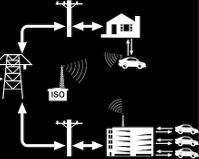
Micro-grids could operate reliably without the need for a national grid backup if they tapped the vast amounts of power stored in the batteries of electric and hybrid vehicles, to balance out fluctuations in supply and demand.
Vehicle-to-grid, or V2G, technology, which will enable electric car owners to make money while storing power for their local micro-grid, was unveiled at the American Association for the Advancement of Science.
The first experimental V2G system went live last year at the University of Delaware, the Christian Science Monitor reported. At Delaware, electric cars are connected to the grid whenever they are not being driven.
The two-way connection not only pulls in power to recharge the battery but can also send electricity out to the home, or the local grid. V2G vehicles work like an electrical sponge, absorbing excess energy when demand for power is low, and returning some when demand is high, said Willett Kempton, project leader at the University of Delaware.
With each car providing 10 kilowatts of power, and up to 10,000 V2G cars in a local area, they would provide a balancing reserve amounting to a megawatt – reducing the need for energy generation construction.
And separate research at Carnegie Mellon University has established that the Lithium Ion batteries which power most electric cars are well suited to V2G usage. “Different degrees of continuous discharge were imposed on the cells to mimic afternoon V2G use to displace grid electricity,” researchers will report in April 2010.
“The loss of battery capacity was quantified as a function of driving days ….more than 95% of the original cell capacity remains after thousands of driving days worth of use.”
Furthermore the cars being tested at Delaware are making five to ten dollars a day just by being plugged in.
This sort of load balancing will become increasingly important as renewable energy sources, particularly wind, generate more electricity.
“Vehicles we have now provide freedom and meet the needs of individuals,” Jeff Stein, engineering professor and V2G researcher at the University of Michigan told the FT. “Hybrid and electric vehicles can also be used in a completely different way, to be something that is defined as being part of the greater good in concert with others. It has fascinating possibilities.”
But the motive need not be altruism. Prof Kempton says his project suggests that an investment in V2G technology could pay off very fast for an electric car owner. Once the technology is commercialised, the additional costs of fitting a V2G-enabled battery and charging system would be about $1,500 – and owners could make $3,000 a year through a load-balancing contract with theirlocal micro-grid.

V2G is economically viable because electric car owners are buying batteries anyway, so it makes sense to use them for communal energy storage. It would be much more costly for electric grids to install stationary battery banks or other storage systems dedicated to load balancing.

One Response
Appreciate the concept of micro power grids as we just published an article on that very subject. The connection between the electric car and micro power grids is particularly appealing as both a load management component and a consumer-generator. Thanks for the insight you’ve provided.